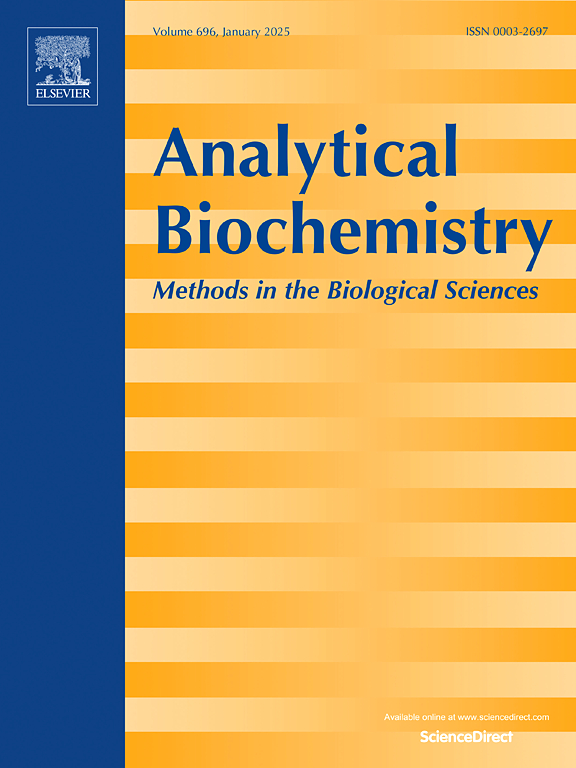Real-time monitoring method of microbial growth using a simple pressure-based respiration detection system
IF 2.5
4区 生物学
Q2 BIOCHEMICAL RESEARCH METHODS
引用次数: 0
Abstract
Dry cell weight (DCW) and optical density (OD) measurement methods provide useful data for assessing microbial growth. However, their sampling process is labor-intensive and time-consuming. Therefore, we aimed to evaluate a method for measuring microbial growth through continuous CO2 measurement under aerobic conditions using a pressure-based respiration detection system, which is traditionally used in anaerobic environments and applies measurement of reduced pressure by capturing CO2 with KOH. The pressure reduction rate, OD, and DCW values were compared during Ralstonia eutropha H16 culture, which revealed a correlation of R2 of 0.99 between the pressure reduction and DCW and a change of DCW (g/L) per pressure (1 mbar) of −0.02 g/L. It showed theoretical limit of detection at 14.67 mbar corresponding to 0.0428 g/L of DCW and theoretical limit of quantification at 48.9 mbar as lower limits. When the pressure-based method was applied to compare carbon source utilization and growth of different strains, such as E. coli sp., Pseudomonas sp., Burkholderia sp., and Bacillus sp., it showed a high correlation with DCW. Overall, these results demonstrate that the pressure-based respiration detection system is a reliable tool for microbial growth monitoring and offers significant advantages by providing real-time data with less labor.

利用简单的压力呼吸检测系统实时监测微生物生长的方法
干细胞重量(DCW)和光密度(OD)测量方法为评估微生物生长提供了有用的数据。然而,他们的采样过程是劳动密集型和耗时的。因此,我们旨在评估一种在有氧条件下使用基于压力的呼吸检测系统通过连续测量CO2来测量微生物生长的方法,该系统传统上用于厌氧环境,并通过用KOH捕获CO2来测量减压。比较真菌性Ralstonia eutropha H16培养期间的减压速率、OD和DCW值,发现减压与DCW的相关系数R2为0.99,每压力(1 mbar)的DCW (g/L)变化为- 0.02 g/L。理论检出限为14.67 mbar,对应于0.0428 g/L的DCW;理论定量限为48.9 mbar。用压力法比较大肠杆菌、假单胞菌、伯克霍尔德氏菌和芽孢杆菌等不同菌株的碳源利用和生长情况,结果显示与DCW高度相关。总的来说,这些结果表明,基于压力的呼吸检测系统是一种可靠的微生物生长监测工具,并且通过提供实时数据而节省人工,具有显著的优势。
本文章由计算机程序翻译,如有差异,请以英文原文为准。
求助全文
约1分钟内获得全文
求助全文
来源期刊

Analytical biochemistry
生物-分析化学
CiteScore
5.70
自引率
0.00%
发文量
283
审稿时长
44 days
期刊介绍:
The journal''s title Analytical Biochemistry: Methods in the Biological Sciences declares its broad scope: methods for the basic biological sciences that include biochemistry, molecular genetics, cell biology, proteomics, immunology, bioinformatics and wherever the frontiers of research take the field.
The emphasis is on methods from the strictly analytical to the more preparative that would include novel approaches to protein purification as well as improvements in cell and organ culture. The actual techniques are equally inclusive ranging from aptamers to zymology.
The journal has been particularly active in:
-Analytical techniques for biological molecules-
Aptamer selection and utilization-
Biosensors-
Chromatography-
Cloning, sequencing and mutagenesis-
Electrochemical methods-
Electrophoresis-
Enzyme characterization methods-
Immunological approaches-
Mass spectrometry of proteins and nucleic acids-
Metabolomics-
Nano level techniques-
Optical spectroscopy in all its forms.
The journal is reluctant to include most drug and strictly clinical studies as there are more suitable publication platforms for these types of papers.
 求助内容:
求助内容: 应助结果提醒方式:
应助结果提醒方式:


